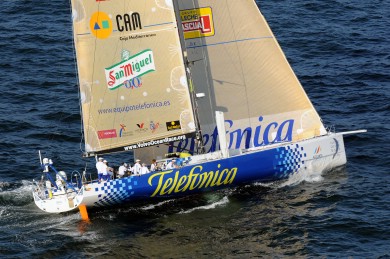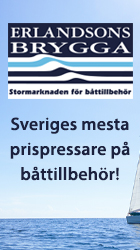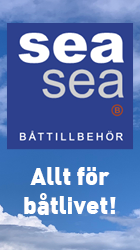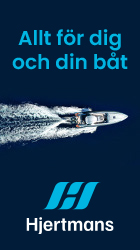Det svänger hela tiden i placeringarna bakom ledarbåten Telefonica Blue (bilden) i Volvo Ocean Race. Delseglatsen på väg från Rio de Janeiro till Boston verkar bli en riktig nagelbitar ända in på mållinjen. Med 2 000 Nm kvar till målet hänger Ericssons båda båtar med riktigt bra. På måndagsmorgonen låg Ericsson 3 tvåa, men hon har nu åkt ner till tredje plats, 3 Nm före systerbåten Ericsson 4.
Över huvud taget har det varit väldigt stor omväxling mellan placeringarna under den här delsträckan, undantaget Telefonica Blue, som har en stabil ledning. Det senaste dygnet har dock Telefonica Blues försprång sjunkit från drygt 100 Nm till cirka 65 Nm.
Tvåa för tillfället är Puma, som har hängt med bra hela tiden. Det skiljer 67 Nm mellan ettan och tvåan medan avståndet mellan tvåan och sjuan (sista båt i fältet) nu är 66 Nm.
Här är den senaste pressreleasen från Race Office:
Monday, 20 April 2009 10:00 GMT
THE TEN ZULU REPORT, LEG 6, DAY 10
By Mark Chisnell
The Doldrums Part IV premiered on Friday night and the fleet has been trading places ever since. Unlike most Part IVs, this one kept the best till last. It was not much short of a full restart as they fought their way into the north-east trade winds.
The one that got away was Telefonica Blue – increasing her lead to over 100 miles as she cleared the Doldrums first. Bouwe Bekking and his merry men still led at 10:00 ZULU this morning, although the fleet was compressing back into them as they sailed into a softer breeze.
Conditions were easing back for everyone this morning, but after a couple of days of power reaching the natural order of things had been restored. The fleet has sorted itself into two neat rows according to the overall points. In the front row we have Ericsson 4, Ericsson 3 and PUMA, lined up from left to right (in that order), with 35 miles of leverage between the two flanks; but only a handful of miles between them on the leaderboard.
In the second row and 40 miles behind, we had Delta Lloyd and Telefonica Black in Ericsson 4’s wake, with Green Dragon following PUMA on the other side of the course. These three had more separation on the leaderboard – around 6 miles of advantage from Telefonica Black to Delta Lloyd, and closer to 20 back to Green Dragon.
Saturday at 10 ZULU – clearing the Doldrums
Let’s go back to the scoring gate before we do anything else, as there was some good stuff that came in over the weekend on this topic – I’d recommend Richard Mason’s audio interview with Amanda Blackley, in which he also gives quite a bit more detail on Magnus Olsson’s broken rib. Apparently, Magnus considered stepping off the boat at Fernando de Noronha – but he stayed on board, and it sounds from the most recent email that things are now a bit more cheerful on board. And don’t miss this footage of Ericsson 4 going past Fernando de Noronha, with skipper, Torben Grael explaining how they nearly lost second place.
They might not have lost second at the gate, but Ericsson 4 did lose it soon afterwards. When we left the fleet on Friday morning they were deep in their transit of the Intertropical Convergence Zone. This time around it hadn’t looked either wide or particularly nasty on the weather maps, with no huge parking lots of zero wind. But there was still plenty of Doldrums weather – squalls and clouds – with the power to shake up the fleet.
There was a difference in opinion on how to tackle the problem, with PUMA and Delta Lloyd following Telefonica Blue and going almost due north. Their plan was to clear the zone as fast as possible. While the two Ericsson boats, Telefonica Blue and Green Dragon, were all steering a more direct north-easterly course, closer to the bearing to Boston, that would simply shorten the distance they had to sail.
As we can see from the weekend’s graph of Distance to Leader (DTL), by the 10:00 ZULU Position Report on Friday morning, Telefonica Blue was already almost clear of the ITCZ. And so began a spectacular rise in her lead that would continue right through to Saturday morning. Navigator, Tom Addis explained in this email that things had gone even better than they hoped, as their lead stretched to over 100 miles. Once again, they were sailing alone, but this time, unlike leg five, the fleet was in the far distance behind them, rather than over the horizon ahead.
Ericsson 4 had not gotten the same breaks, her second place advantage dissolved in warm Atlantic rainwater, as she got badly caught in a cloud. At the 10:00 ZULU Position Report on Friday morning, there were just four miles between second and sixth, and battle commenced to clear the ITCZ first.
Initially, it looked like the northern option that PUMA and Delta Lloyd had taken was going to work, they were into second and third at 13:00 ZULU. But when Ken Read wrote from PUMA shortly afterwards, they were almost motionless, with about two knots of boat speed and watching water spouts form around them. Yikes!
Unsurprisingly, they took a big hit in miles, as Wouter Verbraak recounted in this email – stuck under a cloud “the size of Holland”. And by 16:00 ZULU Ericsson 4 was back up into second. But there was another cycle to come, as once again the north started to come good. PUMA snatched back second place at the 22:00 ZULU Position Report. But even that wasn’t to last, this time around the Doldrums were insisting on a full restart – the ups and downs are captured in the weekend’s graph of Leg Position.
If we check out this graph of wind direction (TWD) and wind speed (TWS) we can see the big shift through Friday afternoon, as they started to get to the edges of the north-east trade winds and the direction began to settle. But the wind speed only really picked up and steadied late Friday evening and very early Saturday morning. And by the time it had done so, at the 04:00 ZULU Report, there was once again less than ten miles separating second to sixth place.
The fleet was now spread in a line, south-west to north-east across the race course. Out on the left flank was the overall leader, Ericsson 4, while 50 miles away on the right flank was the boat closest to her on the overall leaderboard – PUMA. In between, from left to right, were Ericsson 3, Telefonica Black (Green Dragon was the only boat not in this line-up, and she was 15 miles astern of Black), and then Delta Lloyd.
Sunday at 10 ZULU – trade wind reaching
So, by Saturday morning, we had some leverage, and it was just a question of how it would play out over the coming days of reaching in the trade winds. In theory, the boats to the north-east held a slim advantage.
They were in a position to sail a slightly wider and faster wind angle. If we use the Form Guide to find the boat speed at the wind angles (TWA) of 80 and 100 degrees, in 20 knots of wind speed (TWS), the difference is a couple of knots faster at the wider angle. There was nothing to stop the north-eastern boats, PUMA and Delta Lloyd, from sailing that wider angle to try and make gains on the boats to the south-west.
That’s exactly what they did through Saturday and into Sunday morning. Delta Lloyd closed down the leverage faster – probably because, as a first generation boat, she’s a touch slower and needed the wider angle to try and keep up. Or maybe they just stuck the big sail up and went for it. Either way, by Sunday morning at 10:00 ZULU they were the most south-westerly boat in the fleet. PUMA unwound the leverage more slowly, closing the distance to Ericsson 4 down to 30 miles by Sunday morning, with Ericsson 3 positioned between them.
Meanwhile, the second row had started to form with Green Dragon shifting eastwards to sail in PUMA’s lane, some 40 miles behind her, and Telefonica Black moving westwards to sail in Ericsson 4’s wake. Interviewed on Saturday by Amanda Blackley, Telefonica Black’s navigator, Roger Nilson was expecting the wind to go to the east. With everyone sailing below, or west of, the course to Boston, there was evidently widespread agreement that the wind would eventually veer (rotate clockwise) and help them up to the course.
It was a tactical balance that Ericsson 3’s Aksel Magdahl wrote about on Sunday. And we can see from the graph of the weekend’s wind direction and wind speed that it has indeed shifted slowly towards the east, with the result that everyone has gradually altered course to point at Boston.
Meanwhile, at the front of the fleet, Telefonica Blue’s skipper, Bouwe Bekking, was happy with the way his lead had extended in this audio interview from Saturday. His major concern seemed to be that they were at risk of getting into a completely different weather pattern, making it harder to ‘control’ or ‘cover’ the fleet – to stay between them and the finish.
Onwards into Monday – still trade wind reaching…
And as Sunday turned slowly into Monday, Telefonica Blue did start to lead the fleet into the next weather system. It’s a ridge of high pressure and light wind extending out ahead of them from the main Azores High. Unsurprisingly, her lead started to ease back as the wind speed dropped, and was still dropping this morning.
The three boats chasing her directly have stuck rigorously to their formation, the line-up incredibly stable over the 24 hours through to 10:00 ZULU this morning. There was almost nothing in it between the two Ericsson boats and PUMA in those conditions – all of them catching the leader at the same rate. In the second row, Delta Lloyd, Telefonica Black and Green Dragon also seemed to be happy with their position relative to each other, and have stayed in their lanes for the last 24 hours. They just don’t have the pace of the front row, but have been holding steady or gaining on Telefonica Blue as she slowed.
So, what happens next? If you click through the forecasts in the six hourly increments available in the Race Viewer, you’ll see that Telefonica Blue will continue to lead the fleet into a weakening breeze. I’ve set up today’s first Predicted Route image to show the situation in 24 hours time, and you can see the area of light wind still ahead of the fleet, the ridge extending down from the main high pressure zone in the north-east corner of the map.
If you keep going at the six hourly increments, you’ll see that the little ridge of high pressure subsequently fills quite quickly, as the trade winds return. So over the next couple of days Telefonica Blue will see her lead cut further, but she may not get the opportunity to extend again, at least initially, because the high pressure ridge will be filling in as the boats behind get to it. It’s hard to see which side of the main pack will come out best, the early gains should be to the west, but later on the better breeze is in the east.
If we now jump to three days ahead, in this second Predicted Route image, we can see that the boats have just about reached the end of trade wind sailing, and are starting to come under the influence of a low pressure system off the New England coast. It’s these systems that will determine the end of the leg – and if Telefonica Blue plays it right, they will give her every opportunity to make that lead back up, and some.
But check out the five day isochrone – the waves in it show that there are some serious gains and losses to be made, no more flat, even curves progressing steadily north-westwards. The routing has Telefonica Blue making huge gains on the run in, with Green Dragon swerving east to try and stay in touch. Things are about to get interesting. However, the five-day forecast is really unstable at the moment, so we’ll hold off a day or two before we get too fired up about the final 1,000 miles.
And finally, I can’t finish without flagging up a great couple of .tv clips that went up over the weekend. First up, Wouter Verbraak talked through the task of fitting into his third set of crew gear in one Volvo Ocean Race. Speaking as someone who once went through three America’s Cup teams in less than a year, I have some sympathy. Unfortunately, I don’t have a wife with a business degree in work psychology. Or maybe that’s fortunately. Anyway, if you’re a fan of bad taste laughs click here, while for those with a less slap-stick, drier sense of humour, then this clip is for you. And as a bonus, it will probably tell you more about the guys on the Ericsson 4 than just about anything else you’ll see on this lap around the planet …
The TEN ZULU REPORT (so called because it follows the 10:00 GMT fleet position report, and Zulu is the meteorologist’s name for GMT).






